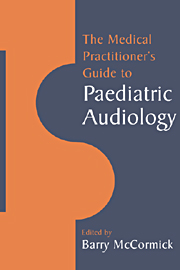Book contents
- Frontmatter
- Contents
- List of contributors
- Preface
- Acknowledgement
- 1 Introduction to hearing problems in childhood
- 2 Causes of deafness
- 3 Behavioural tests
- 4 Pure tone audiometry
- 5 Objective hearing tests
- 6 Middle-ear measurements
- 7 The management of otitis media with effusion
- 8 Management of unilateral hearing loss
- 9 Management of sensorineural hearing loss
- 10 Cochlear implants
- Index
10 - Cochlear implants
Published online by Cambridge University Press: 01 October 2009
- Frontmatter
- Contents
- List of contributors
- Preface
- Acknowledgement
- 1 Introduction to hearing problems in childhood
- 2 Causes of deafness
- 3 Behavioural tests
- 4 Pure tone audiometry
- 5 Objective hearing tests
- 6 Middle-ear measurements
- 7 The management of otitis media with effusion
- 8 Management of unilateral hearing loss
- 9 Management of sensorineural hearing loss
- 10 Cochlear implants
- Index
Summary
Introduction
Cochlear implants are a relatively new form of assistive device for the profoundly deaf who receive little, if any, benefit from the conventional acoustic hearing aids described in Chapter 9. Of the one per thousand children who have profound hearing loss only a very small proportion will be sufficiently deaf to require a cochlear implant. For this small group cochlear implants can provide access to auditory forms of communication and thus help to promote the child's social, emotional and educational development. The function of cochlear implants is to bypass non-functional or absent structures in the cochlea and stimulate the remaining auditory nerve fibres by direct electrical stimulation. The electrically induced nerve impulses are transmitted to the auditory centres of the brain to produce a sensation of hearing (Figure 10.1).
Initially only adults with acquired hearing losses were selected for implantation but since significant benefit from implantation in adults has been demonstrated, considerable numbers of children have been implanted, including young congenitally deaf children. There has been resistance to implantation worldwide, partly because of fears of long term adverse effects of implantation, which have so far not materialised, and also because implantation has been wrongly perceived as a cure for profound deafness rather than as another assistive device.
Cochlear implant design
Hardware
Cochlear implant systems vary in their design but have several common components.
- Type
- Chapter
- Information
- The Medical Practitioner's Guide to Paediatric Audiology , pp. 112 - 125Publisher: Cambridge University PressPrint publication year: 1995

